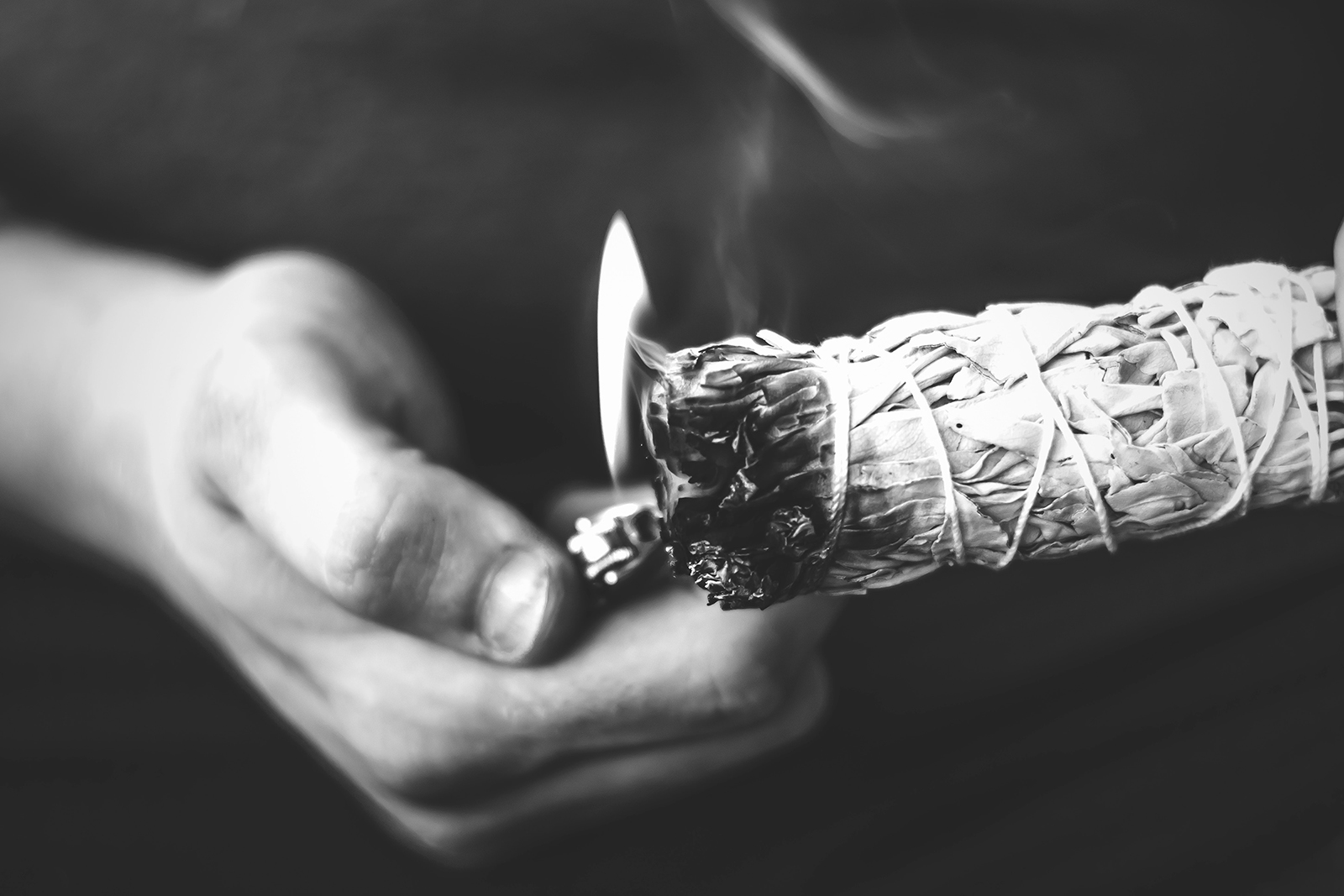As smudging goes mainstream, concerns rise over appropriation, overharvesting
Along with the popularity of white sage comes concern about cultural appropriation, as well as overharvesting.

(RNS) — In their online metaphysical shop Quiiroi, Kitha sells bundles of rosemary, cedar and black sage, as well as mugwort, though they are sold out of that at the moment.
They don’t, however, sell white sage.
That particular herb is a gift from the land meant for Indigenous people, they said.
The 23-year-old witch started Quiiroi in 2020 because they didn’t want to support other metaphysical, New Age and witchy businesses where they felt like their Indigenous culture was being commodified and watered down — in particular, by selling white sage.
“I started my shop because I was always raised with those Indigenous values, and one of those values is that, like, we don’t own Earth. We cannot sell something that we don’t own,” said Kitha, who said their father is Indigenous to Puerto Rico and their mother to the Americas.
“I cannot sell you something, I cannot profit off of something, I cannot financially benefit from something that is meant to be a gift.”
Burning white sage to cleanse a person or space or to attract positive energy has become trendy in recent years, with sage bundles appearing everywhere from starter witch kits to luxury grocery stores. While smudging with sage is often promoted as part of wellness routines, the religious practices around the ritual end up largely removed.
But along with the popularity of white sage comes concern about cultural appropriation, as well as overharvesting.
It’s all “very American,” according to Rosalyn LaPier, an ethnobotanist, environmental historian and professor of history at the University of Illinois at Urbana-Champaign.
Americans have a tendency not only to appropriate cultures, but also to “simplify and reduce them down to the point where it’s not identifiable anymore by the people in that group,” said LaPier, who is an enrolled member of the Blackfeet Tribe of Montana and Métis. She is not a witch.

Rosalyn LaPier. Courtesy photo
White sage is considered sacred in many Indigenous cultures, which all have different stories and teachings about and uses for the plant, she said.
For the Blackfeet, burning sage, or “smudging,” is one form of purification that takes place before interacting with the divine, LaPier said. People might smudge themselves or an object they might use as part of their spiritual practice or a place that might be used for ceremony.
Many religions have similar purification rituals, she pointed out. Catholics cross themselves with holy water before entering a church. Muslims wash their faces, hands, arms and feet before praying. Several traditions use incense to purify spaces or objects.
So, she said, she’s not sure what people think smudging is doing when it’s disconnected from Indigenous spirituality.
“The way I grew up understanding this process, and from talking with elders about this process, that it is something that is definitely connected to religion and religious practice, and it’s not something that you would do unless you were going to interact with the supernatural realm, with the divine,” she said.
It’s not meant to be used for “house cleaning,” said LaPier. “It’s something deeper than that.”
That commercialization has caused problems because white sage is mostly wildcrafted, meaning it’s collected in the wild, rather than farmed, she said. LaPier pointed to reports that white sage has been overharvested to meet demand in the southwestern United States, California and northern Mexico.
Some Native Americans believe it is important to share Native spiritual practices with non-Native people, as one Women’s Health article about smudging pointed out.
“We are more than willing to teach people, to show people our ways,” Shilo and Shawna Clifford, who are Oglala Lakota and own Native Botanicals, told the magazine last year.
“We are just not willing to give others the keys and have them drive away with what is ours. They have to respect that.”

Bundled white sage is burned. Photo by Brittany Colette/Unsplash/Creative Commons
Kitha acknowledged, too, that white sage is meant to be shared.
But after centuries of boarding schools that separated Indigenous children from their families and culture, as well as laws that made Indigenous spiritual practices illegal until the 1978 American Indian Religious Freedom Act, Kitha said, “At this point in time, we deserve to be able to heal and reclaim what’s ours.”
RELATED: Department of Interior releases first report detailing US Indian boarding schools
The commodification of white sage is making it hard once again for Indigenous people to access their spiritual practices, they said.
“It’s getting harder and harder to find. And it’s getting harder and harder to find at a reasonable price point. And we should not even be buying it in the first place because it’s part of our teachings to not sell it,” they said.
LaPier also laments how the sudden trendiness of smudging has flattened the significance of the practice.
“One of the things I would say about sort of the secularizing of smudging is that it really is kind of a reductionist way of looking at Indigenous culture, and of reducing it down to sort of a very simple understanding and a simple method — using one plant, versus lots of different plants for lots of different reasons,” she said.

Peg Aloi. Courtesy photo
Peg Aloi, who calls herself “an older modern Pagan witch,” remembers conversations about cultural appropriation when white sage became popular in Pagan circles back in the 1980s and 1990s, when she first became involved in the witch community.
At the time, Aloi said, there was a lot of overlap between witchcraft and New Age circles. Many Pagans hosted sweat lodges or smudged with sage — “what we now know was appropriating” Native American practices, she said.
So Aloi was surprised when researching ways to spiritually cleanse a building last month that the top results online were still dominated by white sage.
“It’s unfortunate that this is a trend that we already reckoned with decades ago, and here it is again, and the problem once again is lack of education, lack of awareness and, unfortunately, white entitlement. I hate to say that, but that’s really kind of what’s at the center of it,” she said.
“Even though we do have a lot more ethnic diversity in the modern witch community these days, it’s still primarily a white movement.”
Witchcraft sees renewed interest every decade or so, she said, and its current iteration has been fueled by new social media platforms. First there were Tumblr and Instagram witches. Now, there’s #WitchTok.
But while information is made aesthetically pleasing and easily accessible on social media, Aloi said, it often lacks the depth of engagement or knowledge of, say, the shared library beginner witches pored over decades ago.
For instance, while smudging with white sage is widely discussed online, there are many other ways people can cleanse a space spiritually using plants or other items that may come from their own cultures. Some witches don’t use any physical component for cleansing, she said, but she likes something more hands-on.
She ended up using some of her mainstays for the cleansing: rosemary, which she read was used as incense in ancient Rome — something that connects with her Italian heritage — and salt, which is associated with cleansing and purification in many cultures. She also used rosewater, but, she said, “Honestly, that’s just because I’m a gardener.”
If Kitha needs to cleanse something spiritually, they’ll reach for lavender, rosemary or cedar.
If they need a boost of happiness, it might be orange peel or marigold.
So many people seem to view white sage as a “wonder drug,” Kitha said. “But that’s not really what it is. People don’t understand, and, you know, they don’t have the relationship to the plant to understand.”
Different plants have different uses, they said.
Instead of turning to white sage as a spiritual catchall considering all the concerns about its use, they suggested people take the time to form relationships with other plants, to learn the history and folklore surrounding them, to find something that meets a specific need.
“One of the fun things is when you break from the mold of just using white sage for everything, you get to experience so much more,” they said.
RELATED: Is Tumblr witchcraft feminism – or cultural appropriation?
Editor’s note: This article has been updated to clarify that Rosalyn LaPier is not a witch.
No comments:
Post a Comment